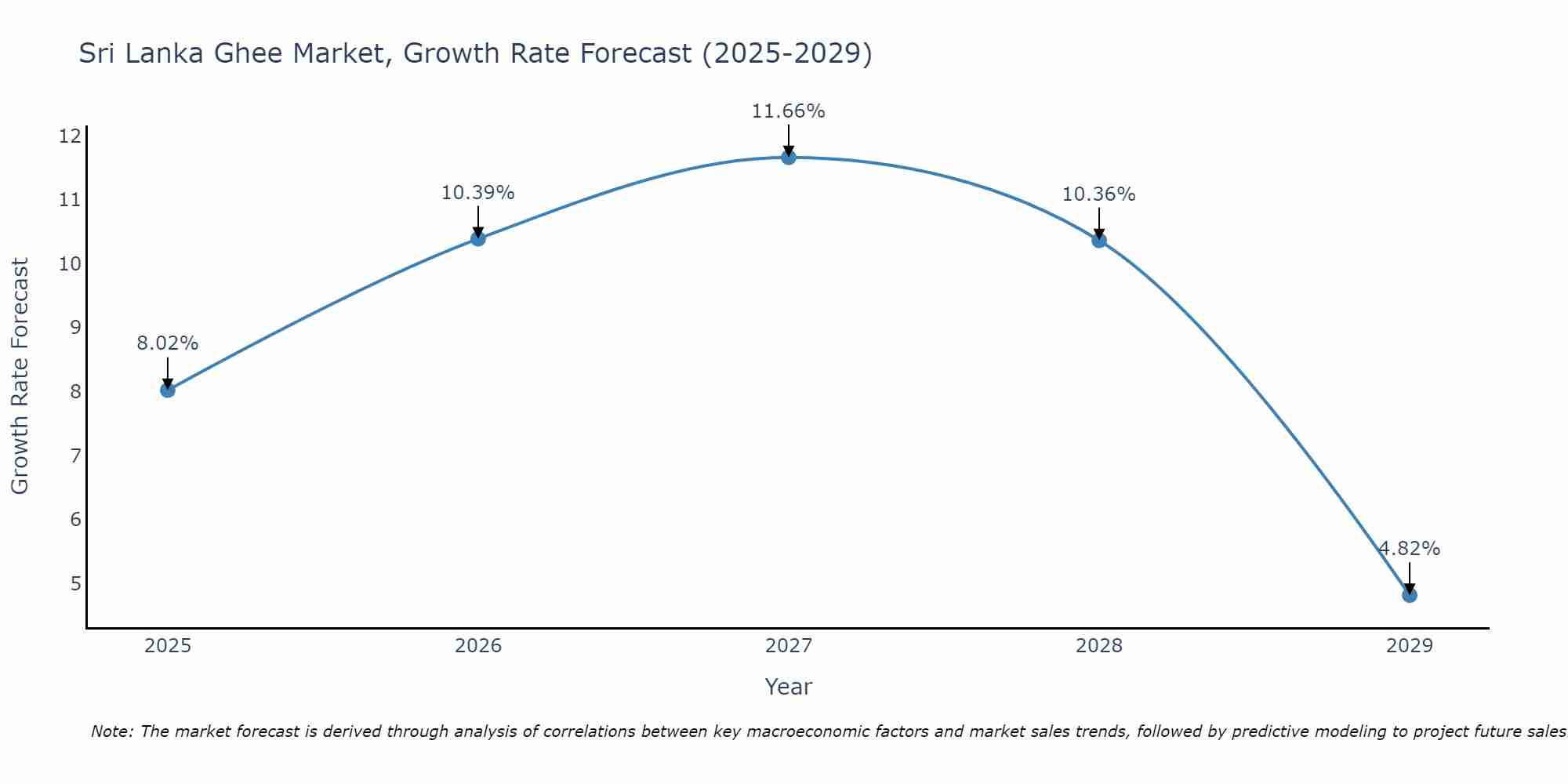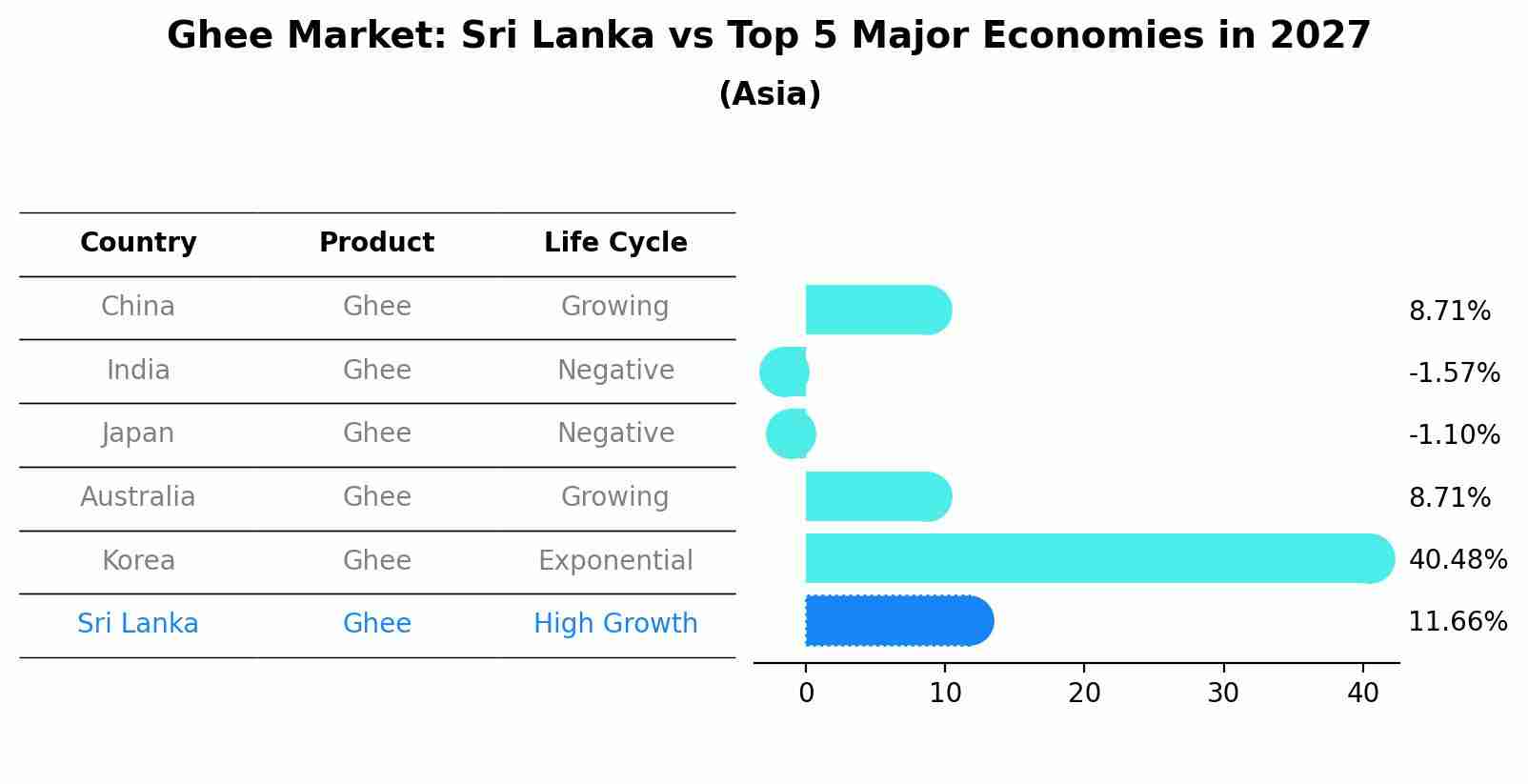Sri Lanka Ghee Market (2025-2031) Outlook | Value, Share, Revenue, Companies, Industry, Size, Growth, Trends, Analysis & Forecast
| Product Code: ETC187843 | Publication Date: May 2022 | Updated Date: Aug 2025 | Product Type: Market Research Report | |
| Publisher: 6Wresearch | Author: Ravi Bhandari | No. of Pages: 60 | No. of Figures: 40 | No. of Tables: 7 |
Sri Lanka Ghee Market Size Growth Rate
The Sri Lanka Ghee Market is projected to witness mixed growth rate patterns during 2025 to 2029. The growth rate begins at 8.02% in 2025, climbs to a high of 11.66% in 2027, and moderates to 4.82% by 2029.

Ghee Market: Sri Lanka vs Top 5 Major Economies in 2027 (Asia)
By 2027, Sri Lanka's Ghee market is forecasted to achieve a high growth rate of 11.66%, with China leading the Asia region, followed by India, Japan, Australia and South Korea.

Sri Lanka Ghee Market Overview
Ghee, a staple in Sri Lankan cuisine, continues to hold a significant market share in the country`s dairy sector. The ghee market is driven by its widespread use in cooking and traditional medicine. Increasing consumer awareness about the health benefits of ghee, coupled with rising disposable incomes, is fueling market growth. The market is characterized by both local production and imports to meet the diverse consumer preferences.
Drivers of the market
The Sri Lankan ghee market is driven by the strong cultural and traditional significance of ghee in the local cuisine. The increasing health awareness among consumers regarding the nutritional benefits of ghee, such as being a good source of vitamins and healthy fats, is also boosting its demand. Additionally, the rising disposable incomes and the growing popularity of organic and high-quality ghee products contribute to the market`s growth.
Challenges of the market
The ghee market in Sri Lanka is constrained by the rising cost of milk and other dairy inputs, which directly impacts the production cost of ghee. Additionally, there is increasing competition from both local and imported ghee brands, leading to market fragmentation and pricing pressures. The market also faces regulatory challenges related to food safety standards and quality control, which can limit the entry of new players and increase compliance costs for existing manufacturers.
Government Policy of the market
The ghee market in Sri Lanka is influenced by agricultural policies aimed at boosting dairy production. Government initiatives include subsidies for dairy farmers, investments in dairy processing infrastructure, and quality control regulations to ensure the production of high-quality ghee, promoting local products over imports.
Key Highlights of the Report:
- Sri Lanka Ghee Market Outlook
- Market Size of Sri Lanka Ghee Market, 2024
- Forecast of Sri Lanka Ghee Market, 2031
- Historical Data and Forecast of Sri Lanka Ghee Revenues & Volume for the Period 2021-2031
- Sri Lanka Ghee Market Trend Evolution
- Sri Lanka Ghee Market Drivers and Challenges
- Sri Lanka Ghee Price Trends
- Sri Lanka Ghee Porter's Five Forces
- Sri Lanka Ghee Industry Life Cycle
- Historical Data and Forecast of Sri Lanka Ghee Market Revenues & Volume By Source for the Period 2021-2031
- Historical Data and Forecast of Sri Lanka Ghee Market Revenues & Volume By Cow for the Period 2021-2031
- Historical Data and Forecast of Sri Lanka Ghee Market Revenues & Volume By Buffalo for the Period 2021-2031
- Historical Data and Forecast of Sri Lanka Ghee Market Revenues & Volume By Mixed for the Period 2021-2031
- Historical Data and Forecast of Sri Lanka Ghee Market Revenues & Volume By End-use for the Period 2021-2031
- Historical Data and Forecast of Sri Lanka Ghee Market Revenues & Volume By Retail for the Period 2021-2031
- Historical Data and Forecast of Sri Lanka Ghee Market Revenues & Volume By Institutional for the Period 2021-2031
- Historical Data and Forecast of Sri Lanka Ghee Market Revenues & Volume By Distribution Channel for the Period 2021-2031
- Historical Data and Forecast of Sri Lanka Ghee Market Revenues & Volume By Supermarkets/Hypermarkets for the Period 2021-2031
- Historical Data and Forecast of Sri Lanka Ghee Market Revenues & Volume By Convenience Stores for the Period 2021-2031
- Historical Data and Forecast of Sri Lanka Ghee Market Revenues & Volume By Specialty Stores for the Period 2021-2031
- Historical Data and Forecast of Sri Lanka Ghee Market Revenues & Volume By Online for the Period 2021-2031
- Historical Data and Forecast of Sri Lanka Ghee Market Revenues & Volume By Others for the Period 2021-2031
- Sri Lanka Ghee Import Export Trade Statistics
- Market Opportunity Assessment By Source
- Market Opportunity Assessment By End-use
- Market Opportunity Assessment By Distribution Channel
- Sri Lanka Ghee Top Companies Market Share
- Sri Lanka Ghee Competitive Benchmarking By Technical and Operational Parameters
- Sri Lanka Ghee Company Profiles
- Sri Lanka Ghee Key Strategic Recommendations
Frequently Asked Questions About the Market Study (FAQs):
1 Executive Summary |
2 Introduction |
2.1 Key Highlights of the Report |
2.2 Report Description |
2.3 Market Scope & Segmentation |
2.4 Research Methodology |
2.5 Assumptions |
3 Sri Lanka Ghee Market Overview |
3.1 Sri Lanka Country Macro Economic Indicators |
3.2 Sri Lanka Ghee Market Revenues & Volume, 2021 & 2031F |
3.3 Sri Lanka Ghee Market - Industry Life Cycle |
3.4 Sri Lanka Ghee Market - Porter's Five Forces |
3.5 Sri Lanka Ghee Market Revenues & Volume Share, By Source, 2021 & 2031F |
3.6 Sri Lanka Ghee Market Revenues & Volume Share, By End-use, 2021 & 2031F |
3.7 Sri Lanka Ghee Market Revenues & Volume Share, By Distribution Channel, 2021 & 2031F |
4 Sri Lanka Ghee Market Dynamics |
4.1 Impact Analysis |
4.2 Market Drivers |
4.2.1 Increasing consumer awareness about the health benefits of ghee |
4.2.2 Growing demand for traditional and natural food products in Sri Lanka |
4.2.3 Rising disposable income leading to higher consumption of premium ghee products |
4.3 Market Restraints |
4.3.1 Fluctuating raw material prices impacting production costs |
4.3.2 Competition from alternative cooking oils and substitutes |
4.3.3 Regulatory challenges related to food safety standards and certifications |
5 Sri Lanka Ghee Market Trends |
6 Sri Lanka Ghee Market, By Types |
6.1 Sri Lanka Ghee Market, By Source |
6.1.1 Overview and Analysis |
6.1.2 Sri Lanka Ghee Market Revenues & Volume, By Source, 2021-2031F |
6.1.3 Sri Lanka Ghee Market Revenues & Volume, By Cow, 2021-2031F |
6.1.4 Sri Lanka Ghee Market Revenues & Volume, By Buffalo, 2021-2031F |
6.1.5 Sri Lanka Ghee Market Revenues & Volume, By Mixed, 2021-2031F |
6.2 Sri Lanka Ghee Market, By End-use |
6.2.1 Overview and Analysis |
6.2.2 Sri Lanka Ghee Market Revenues & Volume, By Retail, 2021-2031F |
6.2.3 Sri Lanka Ghee Market Revenues & Volume, By Institutional, 2021-2031F |
6.3 Sri Lanka Ghee Market, By Distribution Channel |
6.3.1 Overview and Analysis |
6.3.2 Sri Lanka Ghee Market Revenues & Volume, By Supermarkets/Hypermarkets, 2021-2031F |
6.3.3 Sri Lanka Ghee Market Revenues & Volume, By Convenience Stores, 2021-2031F |
6.3.4 Sri Lanka Ghee Market Revenues & Volume, By Specialty Stores, 2021-2031F |
6.3.5 Sri Lanka Ghee Market Revenues & Volume, By Online, 2021-2031F |
6.3.6 Sri Lanka Ghee Market Revenues & Volume, By Others, 2021-2031F |
7 Sri Lanka Ghee Market Import-Export Trade Statistics |
7.1 Sri Lanka Ghee Market Export to Major Countries |
7.2 Sri Lanka Ghee Market Imports from Major Countries |
8 Sri Lanka Ghee Market Key Performance Indicators |
8.1 Average selling price of ghee products in Sri Lanka |
8.2 Consumer purchase frequency of ghee products |
8.3 Number of new ghee product launches in the market |
8.4 Percentage of market penetration in different regions of Sri Lanka |
8.5 Customer satisfaction and loyalty metrics for ghee brands |
9 Sri Lanka Ghee Market - Opportunity Assessment |
9.1 Sri Lanka Ghee Market Opportunity Assessment, By Source, 2021 & 2031F |
9.2 Sri Lanka Ghee Market Opportunity Assessment, By End-use, 2021 & 2031F |
9.3 Sri Lanka Ghee Market Opportunity Assessment, By Distribution Channel, 2021 & 2031F |
10 Sri Lanka Ghee Market - Competitive Landscape |
10.1 Sri Lanka Ghee Market Revenue Share, By Companies, 2024 |
10.2 Sri Lanka Ghee Market Competitive Benchmarking, By Operating and Technical Parameters |
11 Company Profiles |
12 Recommendations |
13 Disclaimer |
- Single User License$ 1,995
- Department License$ 2,400
- Site License$ 3,120
- Global License$ 3,795
Search
Thought Leadership and Analyst Meet
Our Clients
Related Reports
- Afghanistan Apparel Market (2026-2032) | Growth, Outlook, Industry, Segmentation, Forecast, Size, Companies, Trends, Value, Share, Analysis & Revenue
- Canada Oil and Gas Market (2026-2032) | Share, Segmentation, Value, Industry, Trends, Forecast, Analysis, Size & Revenue, Growth, Competitive Landscape, Outlook, Companies
- Germany Breakfast Food Market (2026-2032) | Industry, Share, Growth, Size, Companies, Value, Analysis, Revenue, Trends, Forecast & Outlook
- Australia Briquette Market (2025-2031) | Growth, Size, Revenue, Forecast, Analysis, Trends, Value, Share, Industry & Companies
- Vietnam System Integrator Market (2025-2031) | Size, Companies, Analysis, Industry, Value, Forecast, Growth, Trends, Revenue & Share
- ASEAN and Thailand Brain Health Supplements Market (2025-2031) | Strategy, Consumer Insights, Analysis, Investment Trends, Opportunities, Growth, Size, Share, Industry, Revenue, Segments, Value, Segmentation, Supply, Forecast, Restraints, Outlook, Competition, Drivers, Trends, Demand, Pricing Analysis, Competitive, Strategic Insights, Companies, Challenges
- ASEAN Bearings Market (2025-2031) | Strategy, Consumer Insights, Analysis, Investment Trends, Opportunities, Growth, Size, Share, Industry, Revenue, Segments, Value, Segmentation, Supply, Forecast, Restraints, Outlook, Competition, Drivers, Trends, Demand, Pricing Analysis, Competitive, Strategic Insights, Companies, Challenges
- Europe Flooring Market (2025-2031) | Outlook, Share, Industry, Trends, Forecast, Companies, Revenue, Size, Analysis, Growth & Value
- Saudi Arabia Manlift Market (2025-2031) | Outlook, Size, Growth, Trends, Companies, Industry, Revenue, Value, Share, Forecast & Analysis
- Uganda Excavator, Crane, and Wheel Loaders Market (2025-2031) | Strategy, Consumer Insights, Analysis, Investment Trends, Opportunities, Growth, Size, Share, Industry, Revenue, Segments, Value, Segmentation, Supply, Forecast, Restraints, Outlook, Competition, Drivers, Trends, Demand, Pricing Analysis, Competitive, Strategic Insights, Companies, Challenges
Industry Events and Analyst Meet
Whitepaper
- Middle East & Africa Commercial Security Market Click here to view more.
- Middle East & Africa Fire Safety Systems & Equipment Market Click here to view more.
- GCC Drone Market Click here to view more.
- Middle East Lighting Fixture Market Click here to view more.
- GCC Physical & Perimeter Security Market Click here to view more.
6WResearch In News
- Doha a strategic location for EV manufacturing hub: IPA Qatar
- Demand for luxury TVs surging in the GCC, says Samsung
- Empowering Growth: The Thriving Journey of Bangladesh’s Cable Industry
- Demand for luxury TVs surging in the GCC, says Samsung
- Video call with a traditional healer? Once unthinkable, it’s now common in South Africa
- Intelligent Buildings To Smooth GCC’s Path To Net Zero


















